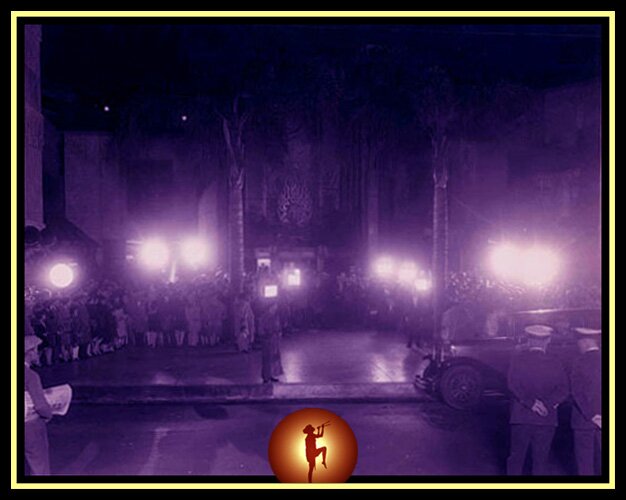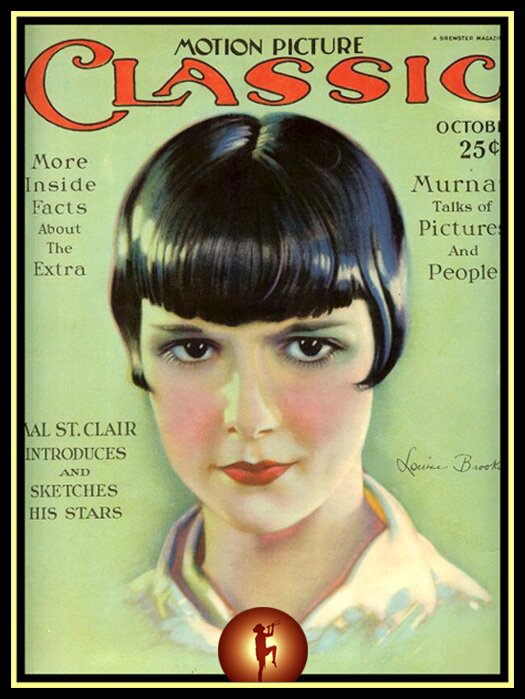|
January 05, 2007 The 3 Ages of My Silent Cinema Journey Part Three: The Age of Enlightenment In my last two blogs I have discussed the ways in which my journey to the Silent Cinema was characterized by both an initial lack of information and a subsequent profusion of misinformation. I eventually came to view the Silent Era though today's historical perspective, which I ultimately decided was unsatisfactory. I felt as though I could almost see the original Silent Cinema but it wasn't quite in focus. Considering the fact that film is a visual medium and the Silent Years were actually well documented, it seemed there should have been a way get a more immediate view of the era. While pondering this issue I considered my first visit to Grauman's Chinese Theater. It was the same theater in which the silent stars had once viewed premieres of their films. It seemed as though the only difference between the past and present should have been a temporal one. When I arrived at Grauman's I was harshly reminded that times had indeed changed. The theater had a different name and the content of the film being shown had absolutely nothing in common with the films of early Hollywood—and I do mean nothing. I examined the cement slabs bearing the handprints and footprints of the stars. I spent time looking at each individual slab considering the size of the prints and imagining the day those prints were made. Constance Talmadge had walked across her slab of wet cement. I wondered how many of the people visiting the forecourt that evening knew who Constance was or even cared for that matter. My first visit to the Chinese Theater turned out to be a disappointment because so much had changed. However it was then I began to realize that my vision of the old Hollywood hadn't really been formed from today's historical perspective after all. The old Hollywood I had longed for was the one I had read about in the Silent Era fan magazines. It was the old Hollywood I had seen in snippets of the Silent Era newsreels as well. I was once lucky enough to receive an invitation to a premiere. It had taken place on a warm summer evening similar to the evening I visited Grauman's. I considered the opening night I had attended and tried to extrapolate from my own experience what premieres might have been like at the Chinese Theater in 1928. It was then I saw the spotlights and the cars and the crowds. I felt as though I was the among the many who were eagerly awaiting the arrival of the stars—Mary Pickford, Douglas Fairbanks, Norma Talmadge, etc. And when the stars arrived they posed for pictures and said a few words as well.
Grauman's Chinese TheaterThose of us with invitations gathered inside the lobby where refreshments were served. We were able to talk to the celebrities when we encountered them. And we talked to everybody we met even if we didn't know them. We usually began by asking how they came to receive an invitation and went on from there. It was great fun. Eventually we exited the lush lobby and entered the theater. A curtain was drawn over the screen but it appeared as though the screen must have been enormous. There was an ashtray on the armrest beside every seat. I thought the patrons were crazy to smoke in the theater while they were watching a nitrate film. And it wasn't doing their health any good either. There was a small orchestra and they were playing the popular music of the twenties. Soon the lights went down and the curtains opened as the music swelled. The screen was indeed huge and there before us, almost engulfing us, was the image of Norma Talmadge in a kind of soft-focus silent glory with amber tints. The music together with the graceful movement of the actors was sublime. This was the glory of the Silent Cinema that I had sought for so many years with limited success. The viewing experience evoked a sensation I had never received from reading the dry film histories with their myriad footnotes. Even now the mere thought of reading those histories can evoke yet another yawn. As I visualized the inherent beauty of the Silent Cinema I realized something very obvious. This is how the moviegoers of the Silent Era came to know the stars. They just watched the films. They didn't learn about the stars from television or the Internet. And they didn't learn about them from history books. They watched the films and read the fan magazines. Since the advent of Sunrise Silents I find myself getting to know some silent films quite well as I prepare them for release. And I find myself reading the fan magazines and photoplay editions as time permits. I am finally getting acquainted with the screen images of a number of silent stars. I can honestly tell you that in all the books I have read (and I have read a great many) I never felt this was the case before now. And somewhere in all of this I have finally identified the reason the historical perspective failed to satisfy me. It was never immediate. I now prefer to approach the silents from what I call the contemporary perspective. And that is an attempt to approach the films as they were approached by Silent Era audiences—without being encumbered by the amalgam of information and misinformation that surfaced after the era ended. When I first saw The General I enjoyed it and still do. However audiences in 1927 didn't consider it to be a great classic and neither do I. Yes I understand the reasons why some consider it to be great. However, a rationale for greatness does not improve the quality of any work. It provides a distraction at best. I believe we do a great disservice to the silents by foisting the reputation of greatness upon films that frankly are not great. What is the point in telling today's audience that mediocre silents are in fact classics? Silent Era audiences knew which films had the potential for greatness—and which did not. Decades have gone by since the close of the Silent Era. And with the passage of time a small number of silent films have been cloaked with reputations woven from the same fabric as the Emperor's New Clothes. I, however, prefer to admit that such reputations are no more based in fact than Abel Gance's Napoleonic snowball and pillow fights. I would much rather watch a silent snowball fight featuring Hal Roach's Our Gang than Abel Gance's Napoleon, and I believe 1927 audiences felt very much the same way. Audiences know whether or not they are being entertained regardless of the number of exposures used to film a scene.
The Fan Magazine - Documentation of the Silent Era.In the Silent Era moviegoers knew the Chaplin who made them laugh rather than the Chaplin who has been analyzed to the nth degree. And they knew his brother Syd almost as well as they knew Charlie. From the contemporary perspective Syd was very popular. Now approximately how many Syd Chaplin films are available on DVD today? I would estimate the number to be somewhere around zero. When it comes to the silents, I want to know the same stars audiences knew in the teens and twenties. I want to go to the source material. I want to view the films for myself. I want to read the fan magazines, which discuss the stars from the contemporary perspective. That is, the star's images are described as they really were—not what somebody else has decided to make them into years after the fact. And I want to read the photoplay editions regardless of whether or not the films are available for viewing. The original films and magazines are the venues by which the contemporary audiences knew the silent stars. And these are the venues by which I choose to know the silent stars today. For the images of the stars were a product of the same Hollywood that expected us to suspend our disbelief for our own good—so we could be entertained. This is the Silent Era I am only now getting to know for the first time and it is far better than any reinvented "Silent Era" I have previously known. For this is the Silent Era as it once was—the Silent Era from the contemporary perspective. We have heard a great deal about the fragility of silent films but little about the condition of the magazines that document Silent Era Hollywood. Those who collect the fan magazines have probably noticed that a number of issues are deteriorating. This is not really surprising considering they are made of paper and were printed a long time ago. I am careful with my magazines—I really am—and whenever I read one, I seem to leave a trail of crumbs behind that fall like snow as I turn every page. And the pages frequently tear because they are so fragile. Sometimes people ask me where they can buy specific issues of the magazines or where they can find an index so they can look up the stars and films they are researching. I tell them it is virtually impossible to buy the magazines on demand. Many of the issues are very difficult to find, especially in complete condition. And currently there is no index of magazine articles. Such were the concerns that inspired me to digitize the fan magazines. The goal is to make the issues available to those who want to read them today—and also to preserve them for posterity. The condition of the old magazines raises one other important point. The copyrights on the film magazines were not renewed and they are therefore in the public domain. However it is probably worth noting that if the copyrights had been renewed the most recent copyright extension would in all likelihood extend beyond the shelf life of the magazines themselves. The same point holds true for a number of extant films. The good news is that there are still plenty of silent film prints and magazines in existence that are not copyrighted. All we have to do is find them, digitize them and make them available. Efforts such as this will better enable all of us to approach the silent film from the contemporary perspective. I believe such an approach can by summed up by paraphrasing Eliza Doolittle in My Fair Lady—don't tell me, show me. Don't tell me about the silents—just show me the films. Films are an art rather than a science. And as such there need be no rigorous or tedious aspects to the process of getting to know them. Alfred Hitchcock used to say, "It's only a movie." Mr. Hitchcock was correct. The movies are only movies—nothing more and nothing less. And the movies are all about entertainment. So let's sit back, relax, and watch the films—and let's have some fun! |
|
|


